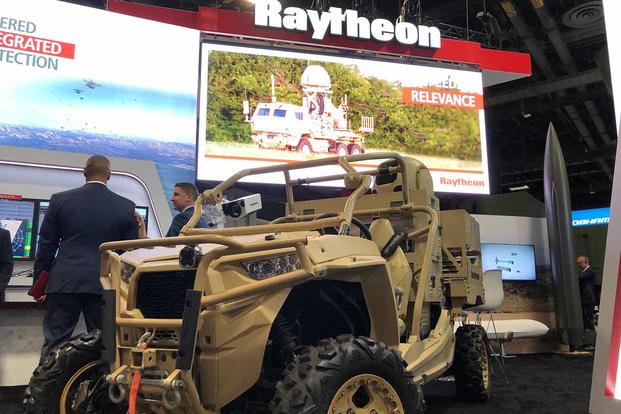As the Army moves forward with plans to mount anti-drone lasers on Stryker vehicles, the Air Force is preparing to send its own vehicle-borne laser drone-killers overseas in just a few months.
Raytheon Space and Airborne Systems received a $23.8 million contract from the Air Force in August for two prototype high-energy laser weapons systems, designed to take out threatening unmanned aerial systems. The plan, according to contracting documents, is to deploy the systems for a year for testing and experimentation, wrapping up the effort by November 2020.
At the same time, the Air Force has contracted with Raytheon for a $16 million prototype Phaser high-powered microwave counter-drone system, to be deployed and tested by service personnel within the same timeframe.
At the Association of the United States Army annual meeting in Washington, D.C., this week, Raytheon executives said one of the high-energy laser systems has already been delivered to the Air Force, and the other will follow shortly.
Related: Check out Military.com's coverage of the AUSA Conference
"Where overseas, I can't disclose, but it is multiple [combatant commands]," said Evan Hunt, director of business development for high-energy lasers at Raytheon. "They have planned them for multiple different [areas of responsibility]."
It will represent the first overseas deployment for the system, a milestone as major defense companies scramble to deliver smart solutions to counter a growing and diverse threat from enemy drones.
At AUSA, the spherical laser multi-spectral targeting system was mounted on a lightweight Polaris MRZR all-terrain vehicle, a popular transport for special operations troops and small infantry elements.
The system uses radar to detect and track unmanned aerial systems as small as commercial quadcopters, delivering data to a targeting screen. A human user can then employ an Xbox controller to lock in on a target and deploy the laser to shoot it down.
In promotional materials for the system, Raytheon says it has near-infinite firing capacity. "The cost per shot is basically the cost of electricity," the company said in a recent release.
"At this point, the directed energy systems are being deployed for air base air defense," Hunt said. "You could imagine it being parked at the end of the runway, being operated. They are being operated by U.S. Air Force troops, likely to be security forces troops ... looking for drones that are either surveilling or potentially posing a threat, and countering them."
The first system is likely to be sent overseas for field assessments in the first quarter of next year.
Regarding the Phaser, a high-powered microwave mounted on a box similar to a shipping container, the Air Force wants experimentation to include operator training, system maintenance and mission operation, according to contract documents.
The Phaser emits radio frequencies "in a conical beam from a dish," according to Raytheon promotional materials, and is designed to bring down large swarms of attacking drones at once.
That system, Hunt said, will likely be deployed and in testing by the Air Force by the middle of next year.
-- Hope Hodge Seck can be reached at hope.seck@military.com. Follow her on Twitter at @HopeSeck.
Read more: Men and Women Seeing Different Failure Rates on Army's Gender-Neutral Fitness Test













